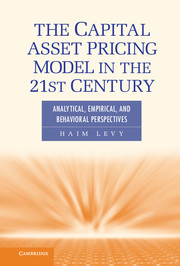 The Capital Asset Pricing Model in the 21st Century
The Capital Asset Pricing Model in the 21st Century Book contents
- Frontmatter
- Contents
- Preface
- 1 Introduction
- 2 Expected Utility Theory
- 3 Expected Utility and Investment Decision Rules
- 4 The Mean-Variance Rule (M-V Rule)
- 5 The Capital Asset Pricing Model
- 6 Extensions of the Capital Asset Pricing Model
- 7 The Capital Asset Pricing Model Cannot Be Rejected
- 8 Theoretical and Empirical Criticism of the Mean-Variance Rule
- 9 Prospect Theory and Expected Utility
- 10 Cumulative Decision Weights
- 11 The Mean-Variance Rule, the Capital Asset Pricing Model, and the Cumulative Prospect Theory
- References
- Name Index
- Subject Index
6 - Extensions of the Capital Asset Pricing Model
Published online by Cambridge University Press: 05 June 2012
- Frontmatter
- Contents
- Preface
- 1 Introduction
- 2 Expected Utility Theory
- 3 Expected Utility and Investment Decision Rules
- 4 The Mean-Variance Rule (M-V Rule)
- 5 The Capital Asset Pricing Model
- 6 Extensions of the Capital Asset Pricing Model
- 7 The Capital Asset Pricing Model Cannot Be Rejected
- 8 Theoretical and Empirical Criticism of the Mean-Variance Rule
- 9 Prospect Theory and Expected Utility
- 10 Cumulative Decision Weights
- 11 The Mean-Variance Rule, the Capital Asset Pricing Model, and the Cumulative Prospect Theory
- References
- Name Index
- Subject Index
Summary
Introduction
Although this book is devoted mainly to the classic Capital Asset Pricing Model (CAPM) and its relation to behavioral economics, it is worthwhile to discuss briefly the other related risk–return models, particularly the various extensions of the CAPM.
The Sharpe–Lintner CAPM was derived under a set of assumptions, some of which are very restrictive and some of which are in sharp contradiction to what one observes in practice. There are two basic courses one can take to handle these restrictive and unrealistic assumptions. The first course relies on the positive economics approach suggested by Milton Friedman, asserting that in some models, although the underlying assumptions clearly do not hold in practice, it is still justifiable to use these models as long as investors behave “as if” these assumptions hold. The procedure to examine whether investors behave as if the assumptions are intact is done by examining the empirical fit of the data to the estimates predicted by the model under scrutiny. If there is a good fit between the theoretical estimates of the model and the observed data, then the theoretical model can be safely used despite the unrealistic assumptions made to derive it.
- Type
- Chapter
- Information
- The Capital Asset Pricing Model in the 21st CenturyAnalytical, Empirical, and Behavioral Perspectives, pp. 156 - 185Publisher: Cambridge University PressPrint publication year: 2011
- 1
- Cited by


